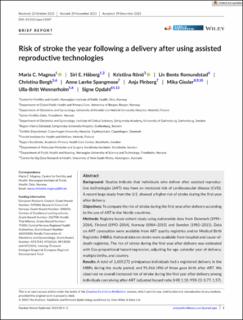| dc.description.abstract | Background
Studies indicate that individuals who deliver after assisted reproductive technologies (ART) may have an increased risk of cardiovascular disease (CVD). A recent large study from the U.S. showed a higher risk of stroke during the first year after delivery.
Objectives
To compare the risk of stroke during the first year after delivery according to the use of ART in the Nordic countries.
Methods
Registry-based cohort study using nationwide data from Denmark (1994–2014), Finland (1990–2014), Norway (1984–2015) and Sweden (1985–2015). Data on ART conception were available from ART quality registries and/or Medical Birth Registries (MBRs). National data on stroke were available from hospital and cause-of-death registries. The risk of stroke during the first year after delivery was estimated with Cox proportional hazard regression, adjusting for age, calendar year of delivery, multiple births, and country.
Results
A total of 2,659,272 primiparous individuals had a registered delivery in the MBRs during the study period, and 91,466 (4%) of these gave birth after ART. We observed no overall increased risk of stroke during the first year after delivery among individuals conceiving after ART (adjusted hazard ratio [HR] 1.10; 95% CI: 0.77, 1.57). Similarly, there was no convincing evidence that the short-term risk of stroke was higher within 1, 2, 3, or 6 months after delivery, with adjusted HRs ranging between 1.23 and 1.33 and confidence intervals including the null value for all time periods. A secondary analysis also including multiparous individuals (n = 3,335,478) at the start of follow-up yielded similar findings.
Conclusions
We found no evidence of an increased short-term risk of stroke among individuals who delivered after using ART. | en_US |

